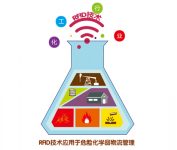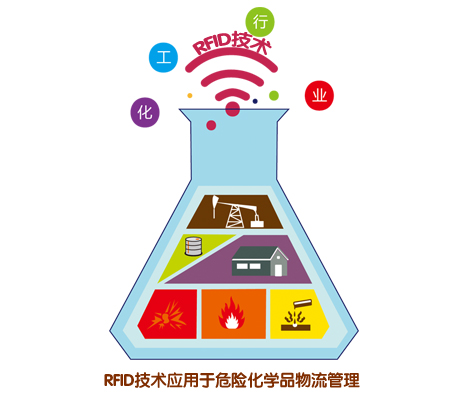
RFID lays a solid foundation for the management of hazardous chemicals
[ad_1]
Due to the special requirements for the safety of dangerous goods storage, the storage, transportation, and use are relatively strict. RFID technology performs automatic data collection, real-time control of the status of hazardous chemicals, improves the existing data collection and supervision methods of hazardous materials, and greatly improves the level of safety management of hazardous materials storage. The RFID hazardous chemicals management system is aimed at the current pain points in the management and control of hazardous chemicals.
At present, it is divided into two parts: one is to manage the high-risk chemicals in the cabinet through RFID smart cabinet, and the other is to manage the hazardous chemicals in the warehouse through the RFID management system.
RFID hazardous chemicals management cabinet products: mainly targeted at medical, education, chemical and chemical industries that need to manage controlled hazardous chemicals. The RFID technology effectively solves the disadvantages of the original traditional operation. It can be unattended for 24 hours. The user can take dangerous chemicals at will, and people without authorization can not touch the dangerous chemicals. Prevent others from falsely claiming and irregular operations. , Managers can understand the use of hazardous chemicals in real time. Through the RFID intelligent hazardous chemical storage cabinet, you can understand the use status of controlled drugs and related user information in real time. The weighing system of the RFID intelligent hazardous chemical storage cabinet can also understand the weight information of the controlled drugs. The internal temperature and humidity monitoring and camera are integrated. Wait for sensors to ensure the safety of the entire hazardous chemicals control.

An RFID management system is integrated in the hazardous chemical storage cabinet to monitor the status of the items in the cabinet in real time. The 24-hour intelligent cabinet system manages hazardous chemical products without human intervention, and can legally obtain internal hazardous chemical products in real time. Open the door through the task application form and authority. People without authority can not open the cabinet door, and the accountability system is managed. The cabinet door can be opened by swiping the card/fingerprint/mobile phone verification code. The smart cabinet system controls the camera to take a snapshot at the moment the door is opened to ensure that the door is opened for the user, preventing fraudulent use of the identity of others.
RFID management system warehouse management:
1. Cargo location management
An electronic label is installed on each dangerous chemical product. The label records various performance and characteristics of the dangerous product, such as storage location, production date, manufacturer, name, hazard, storage method, use safety matters, and transportation safety matters And other information. Then transfer this information to the company’s management database, so that the company can quickly understand the distribution status of chemicals in the warehouse, storage time and other information.
2. Inbound and outbound operations
Scan the barcode through the wireless terminal, efficiently handle the warehouse entry and exit, clearly understand the situation of chemicals entering and exiting the warehouse, and implement real-time updates of the warehouse data. It can clearly reflect the proportion of various chemicals in sales in the database, and at the same time, it can avoid the time wastage caused by man-made reasons and the illegal use of dangerous goods by others. Ensure the safety of safety products.
3. Inventory
Scan the electronic tags of cargo location and material electronic tags through the wireless terminal, and check the material inventory in real time. In the system, random spot checks can be divided into warehouses, regions, and cargo locations, and spot checks can also be made for specific types. At the same time, the entire system can be checked regularly. A comprehensive inventory and a difference table are generated to facilitate the analysis and tracking of which materials belong to the materials with low inventory accuracy. At the same time, some materials that have not been used for a long time are dynamically analyzed and warnings are issued.
4. Quality traceability
Through the safety traceability system, you can learn about the production time, manufacturer, and expiration date of hazardous chemicals. In the course of use, once it is found that the chemical does not meet the safety standards, it is necessary to take effective measures in time to report the situation to the manufacturer in a timely manner. Avoid causing greater safety accidents.
5. Inquiries, statistics, reports:
Including customer shipping statistics query, product tracking, channeling management, serial number query and other management reports, inventory dynamic query/detailed list, query, statistics, and report generation of various documents. Form textual content. Convenient for review.
Through RFID technology, the warehouse is fully managed and controlled to form an intelligent and information-based warehouse management. RFID technology collects real-time data on the entry and exit of hazardous chemicals in the warehouse and the usage status, hazardous chemical production, entry and exit, and transportation management. RFID-based dangerous goods storage management uses modern information collection technology and information transmission methods to solve the current problems of backward data collection methods and inadequate monitoring, thereby achieving the purpose of safety management such as timely stopping illegal behavior and preventing accidents. The adoption of RFID technology improves the efficiency of hazardous chemical management, makes hazardous chemical supply chain management more scientific, and lays a solid foundation for the safety and quality of hazardous chemicals.
[ad_2]



